
Do You Have Indoor Allergies?
Feb 02, 2018by Angela Cummings and Sophia Ruan Gushée
Do you sometimes come home after being out of the house all day and experience chronic symptoms: scratchy throat, headache, itchy eyes, or stuffy nose? Could it be an allergic reaction to your indoor environment?
According to the Center for Disease Control, “More than 50 million Americans suffer from allergies each year.”(1) Allergies can lead to a chronic illness, which becomes costly. The Center for Disease Control estimates that “Allergies are the 6th leading cause of chronic illness in the U.S. with an annual cost in excess of $18 billion.”(2)
Indoor Allergy Symptoms
Indoor allergies can be hard to distinguish from an illness. For example, allergies and the typical cold or flu share symptoms: fatigue, nasal congestion, headache, fever, and cough. Below explores a few differences though.
Allergies
Allergic reactions involve the “release of IgE (immunoglobulin E) antibodies, histamine, and other chemicals [released by] the immune system.”(3)
Symptoms that are different from a cold or flu are:(4)
- wheezing
- shortness of breath
- rash
- nausea
- vomiting
Sometimes the chronic condition, Multiple Chemical Sensitivity (MCS), can be confused with allergic reactions since they, too, share similar symptoms. However, since MCS does not involve the release of IgE antibodies or histamines, it is not considered an allergic reaction.(5)
Cold/Flu
Symptoms that are different from allergies are:(6)
- sore throat
- muscle or body aches
- discolored mucus (yellow or green)
4 Typical Indoor Allergy Causes
1. Dust
Household dust is made up of particles that fall off of pets, people, and objects. It includes pet dander, bug parts, dead skin cells (from you and me), clothing lint, mold spores, bath towel fuzz, plastic bits from computers and electronics, and chemicals that comprise our household items (e.g. pesticides on fur, chemical cleaners, and fire retardants in electronics).
2. Chemicals
Chemicals in phthalates, surfactants/sulfates and VOCs may cause or trigger allergic reactions.(7) Examples of how these chemicals enter our home include:
- Phthalates: caulk, plastic food containers, pesticides, textiles, upholstery, and children’s toys
- Surfactants/sulfates: adhesives used in furniture, leather, paints, and textiles
- VOCs: candles, synthetic essential oils, cleaning products, air fresheners, composite wood, furniture, and flooring
3. Mold
Mold is found indoors and outdoors in various amounts. It can enter your house from open windows and doors, heating and cooling systems, and be tracked in on clothing, shoes, pets, and people.(8)
4. Dust mites
Dust mites are tiny little arthropods that are similar to spiders. They eat the dried skin that humans shed every day. People can be allergic to the dust mite, their waste, and their deceased bodies, all of which can be found in couches, carpeting, dust, stuffed toys, pillows,, and bedding.(9)
Do You Have Indoor Allergies?
Indoor allergies can be diagnosed in two primary ways: by allergy testing, or by paying attention to patterns.
Allergy Testing
Allergists can test for reactions to pet dander, mold, dust mites and even some chemicals (like formaldehyde). The testing is typically done one of two ways: skin test and blood test.
- Skin test: The skin test is the most common allergy test used. It’s relatively painless, affordable, and shows results in 20 minutes.(10)
- Blood test: The blood test requires drawing and analyzing blood. It takes longer to get results.(11)
Patterns
There are typically patterns that develop with allergic reactions. For example, when you pet an animal your nose gets stuffy. Or when you spend time in your house during nights and weekends, you have a frequent headaches. These patterns could hint at allergy triggers.
3 Tips for Indoor Allergies
You can follow these general guidelines when considering how to reduce indoor allergens. However, start with your trusted medical professional, who can provide individualized health care that takes your entire health (history, current illnesses, specific symptoms, etc) into consideration.
1. Consult an Allergist and/or Environmental Medicine Doctor
Indoor allergies can be caused by a combination of factors. Traditional allergists consider factors such as dust, dust mites, pets whereas traditional Environmental Medicine professionals consider the “clinical aspects of humans and their environment.”(12) The American Academy of Environmental Medicine (https://www.aaemonline.org/aboutus.php) is one tool available to find physicians and other environmental medicine professionals.
2. Avoid allergens
The most effective way to stop allergic reactions without medication is to avoid the allergen. For example, if flowers are causing an allergic reaction, avoid bringing fresh flowers into the house. Similarly, if chemicals are causing an allergic reaction, avoid buying products such as air fresheners, paints and finishes with high amounts of VOCs, synthetic materials, and other chemicals that could be harmful to health.
3. Control the indoor environment
Keep your house dusted and cleaned to help reduce allergy triggers such as mold, dust, dust mites, and chemicals that can stick to dust, clothes, drapes, furniture, bedding and other materials. Fully clean your home with a HEPA vacuum or damp rag at least once per week to minimize dust.
References
(1)(2) Center for Disease Control - Allergies
(3)(5) Johns Hopkins Medicine
(4) American College of Allergy, Asthma & Immunology
(6) Center for Disease Control - Flu
(7) A to Z of D-Toxing, Works Cited Part 2
(8) Center for Disease Control - Mold
(9) Asthma and Allergy Foundation of America
🎁 unlock your ULTIMATE HOME DETOX™ starter pack
Download the Ultimate Home Detox™ Starter Pack—your free set of practical, science-backed tools to begin reducing toxic exposures in your everyday life.
- Nontoxic Cleaning Guide
- Forever Chemicals Detox Starter
- EMF Detox Challenge
- Safe Cookware Starter Kit
- Kitchen Detox Checklist
- Fertility / Pregnancy / Children's Detox
Join 349,000+ people who’ve turned to Ruan Living for trusted, practical nontoxic guidance. These resources have helped thousands begin their journey toward a healthier home—and they’re yours, free.
GET YOUR ULTIMATE HOME DETOX™ STARTER PACK NOWWe hate SPAM. We will never sell your information, for any reason.



